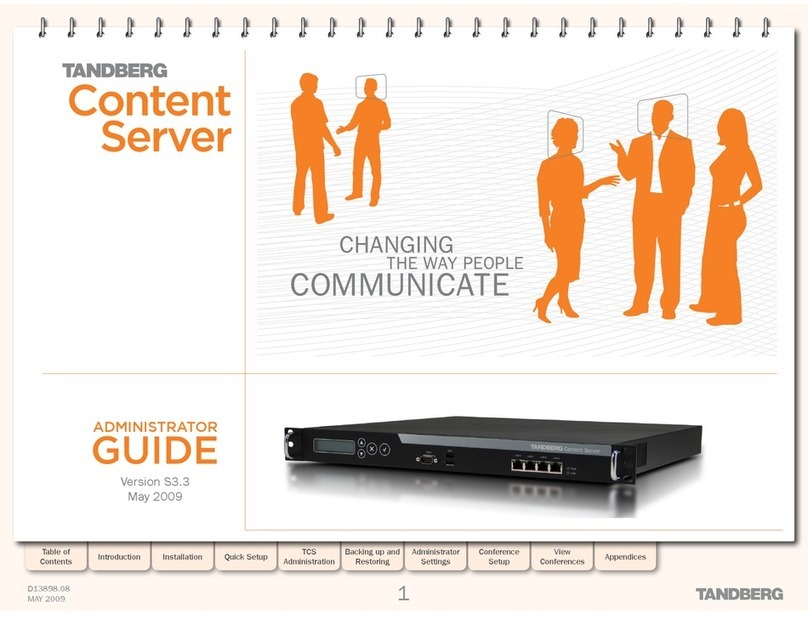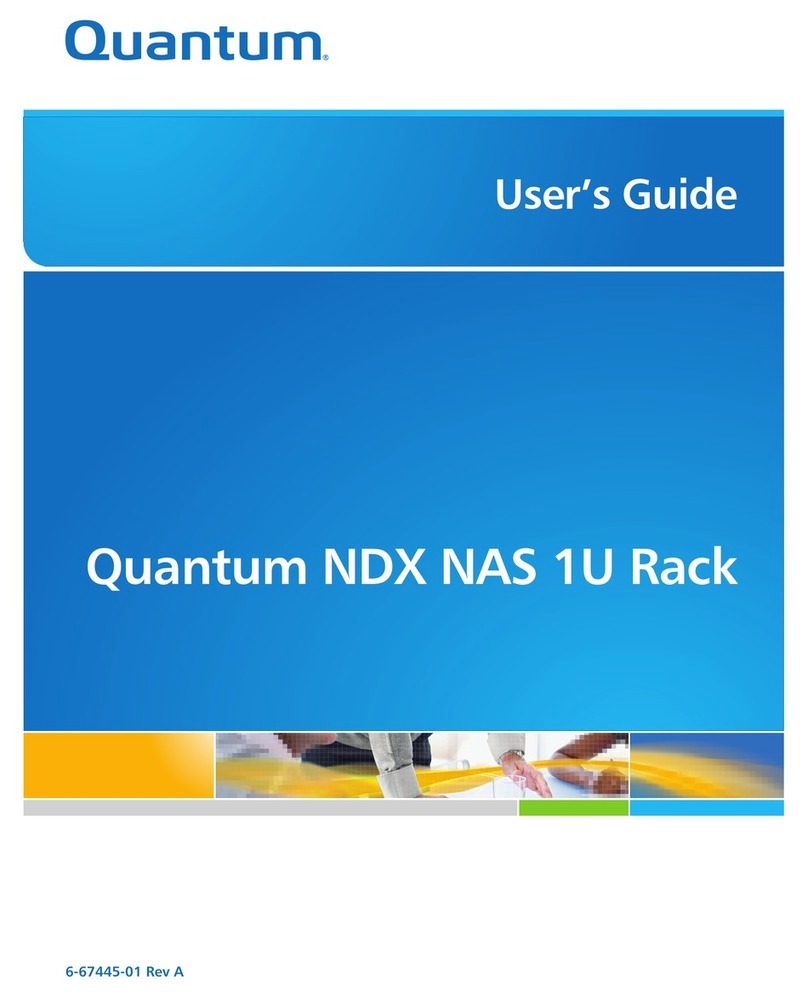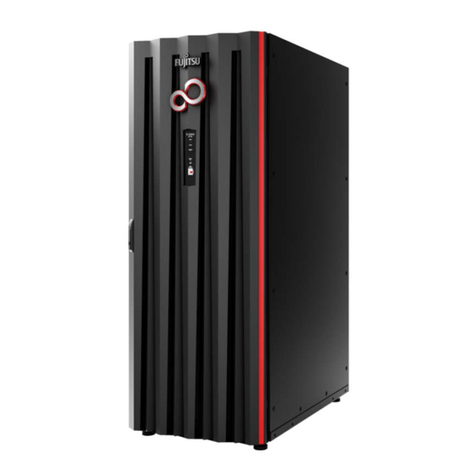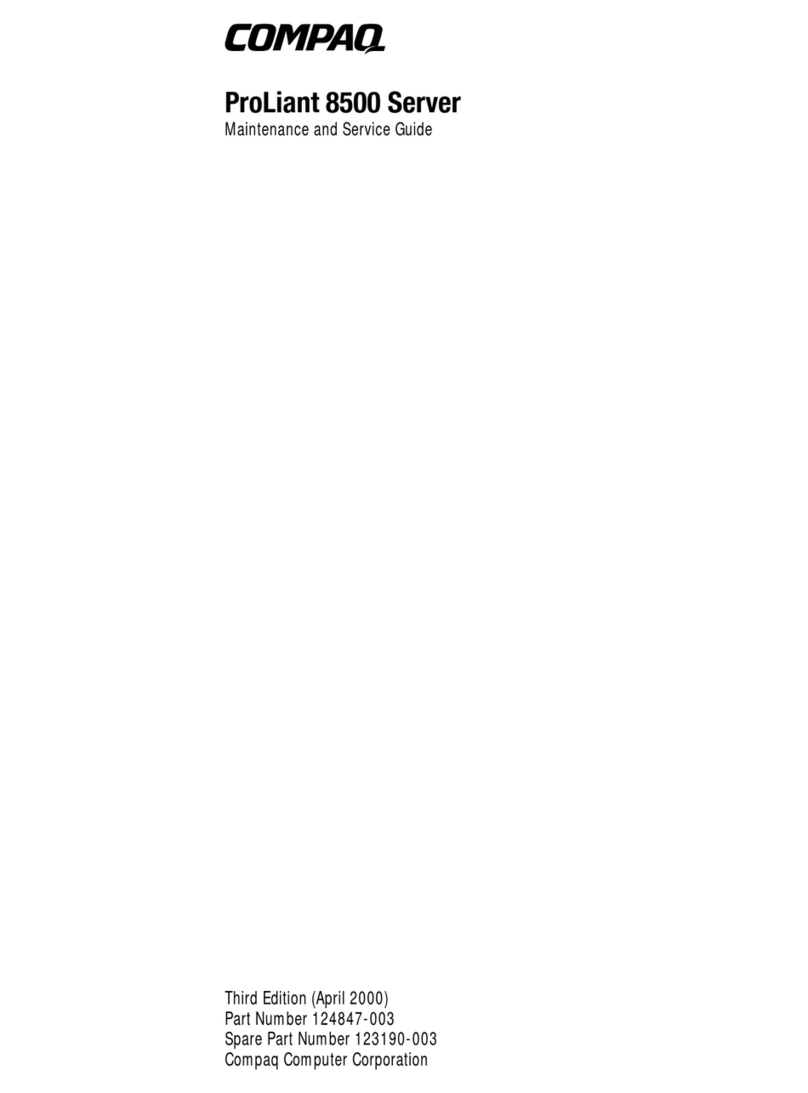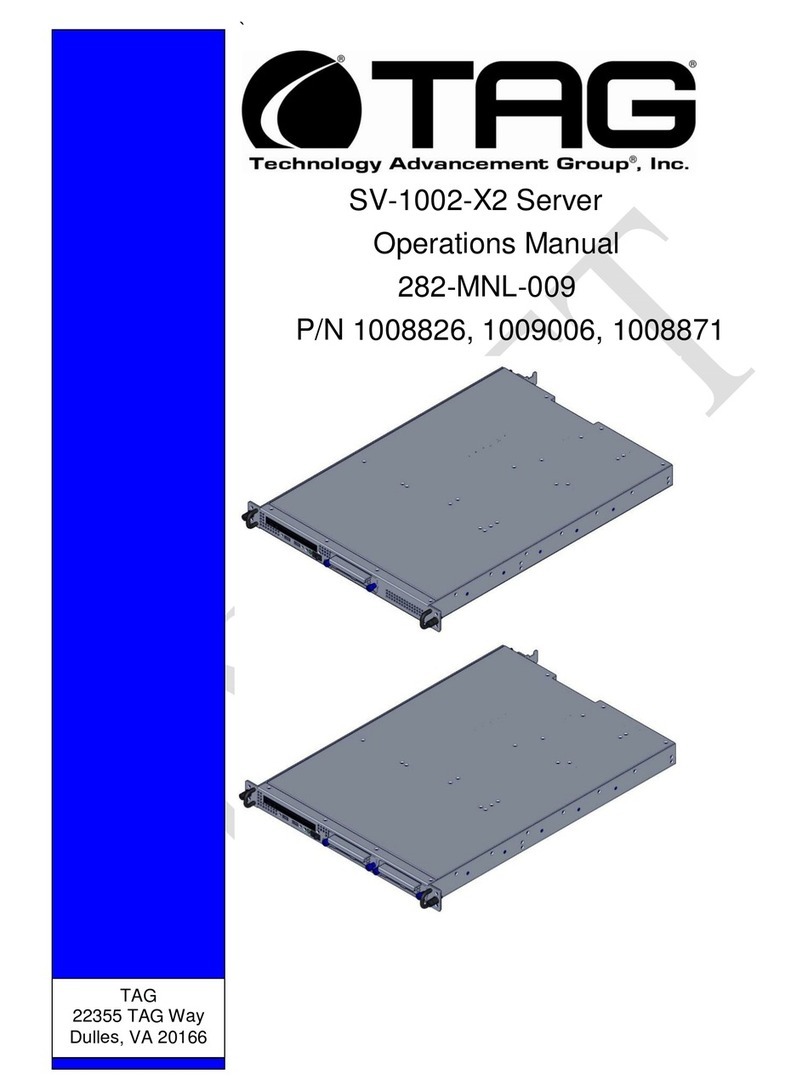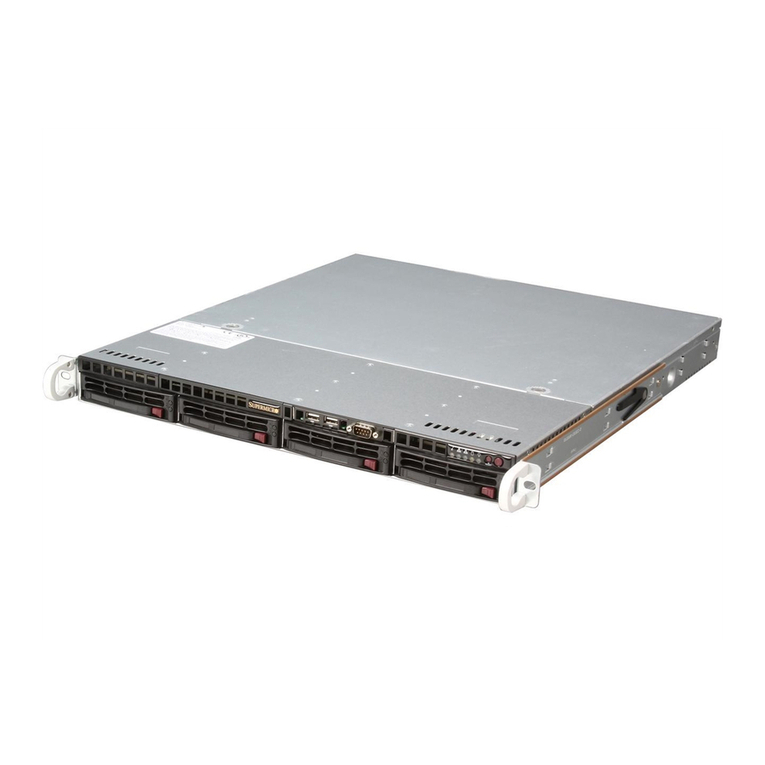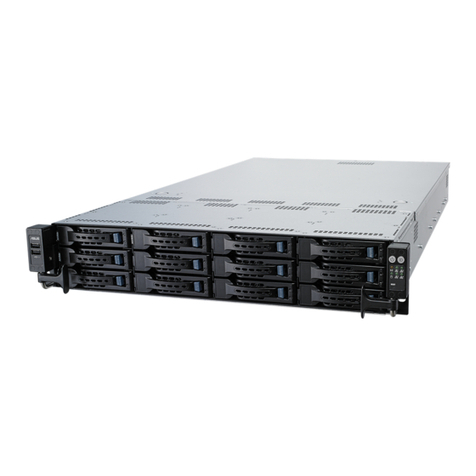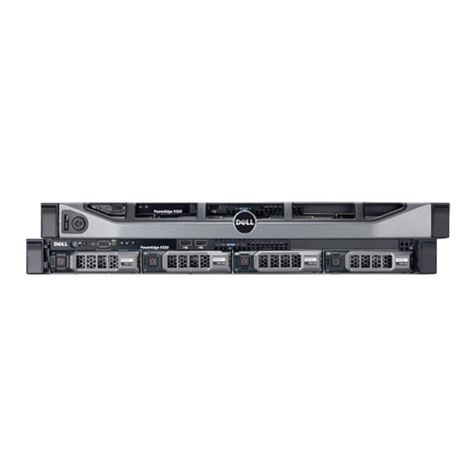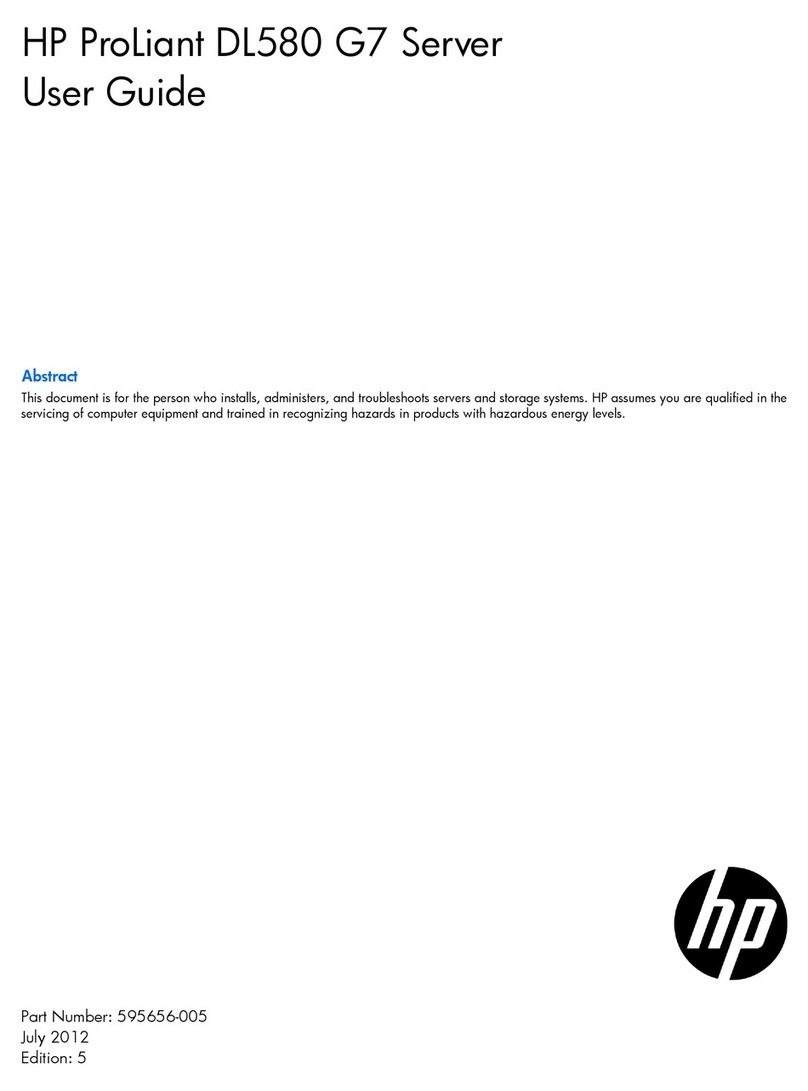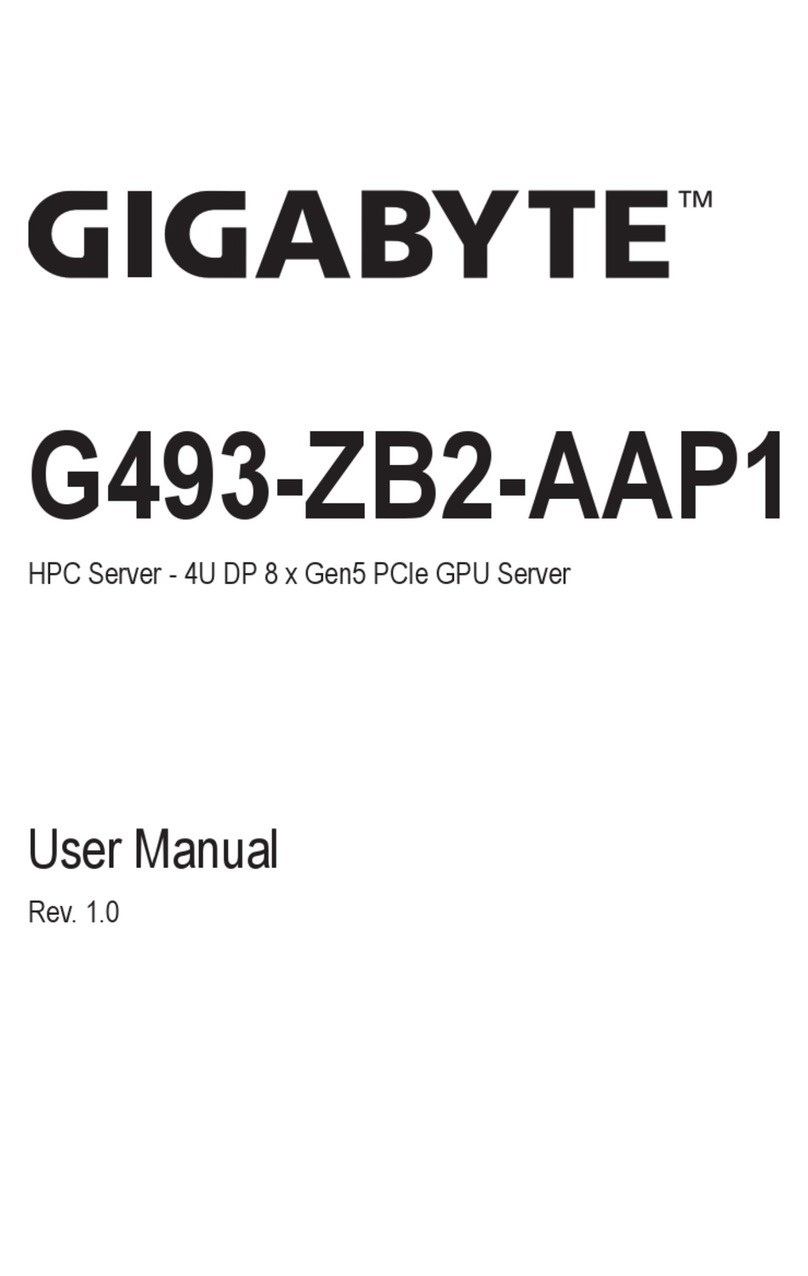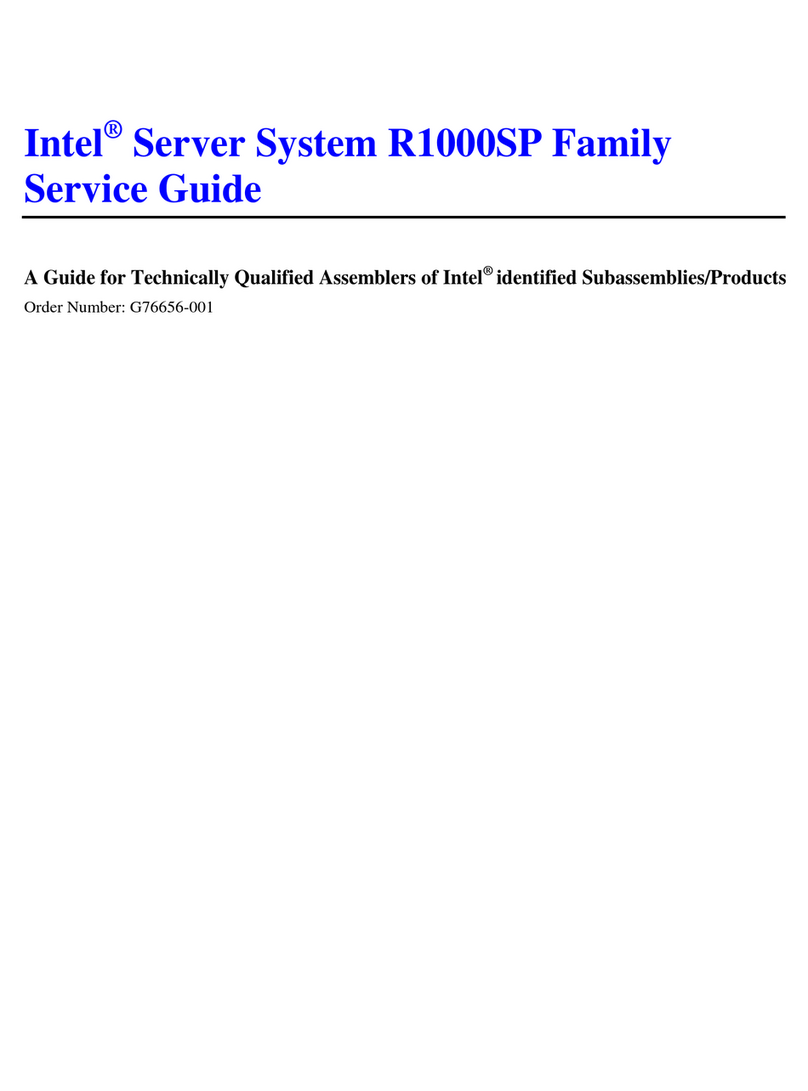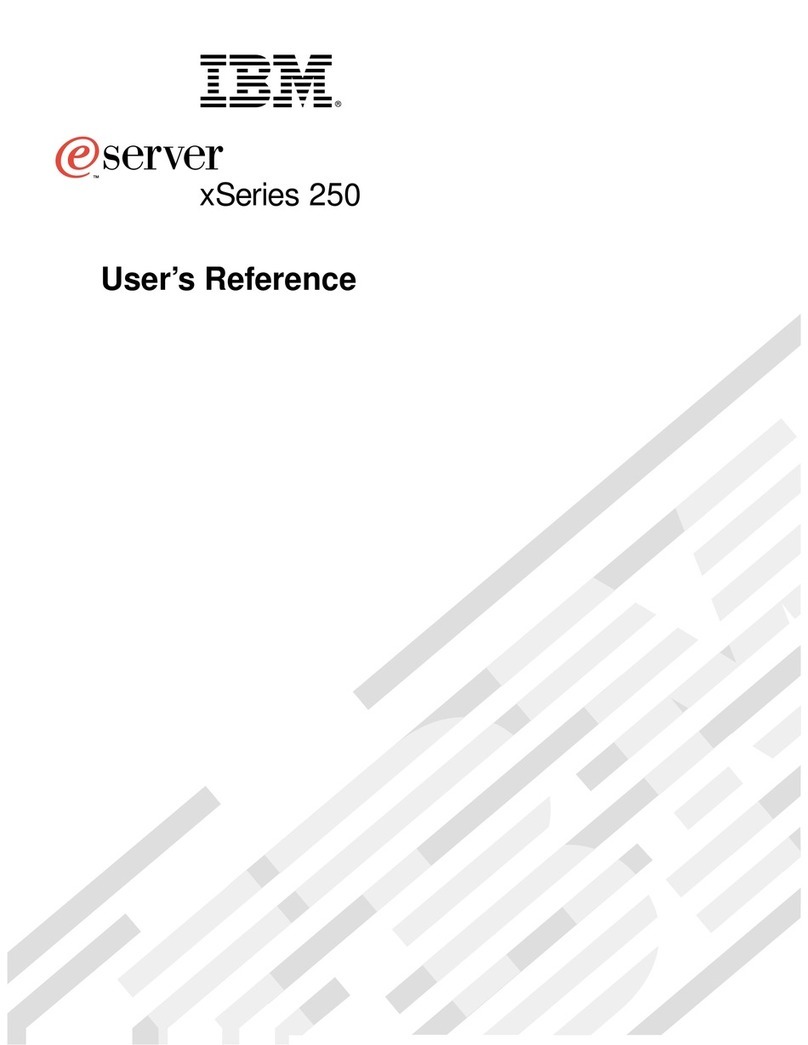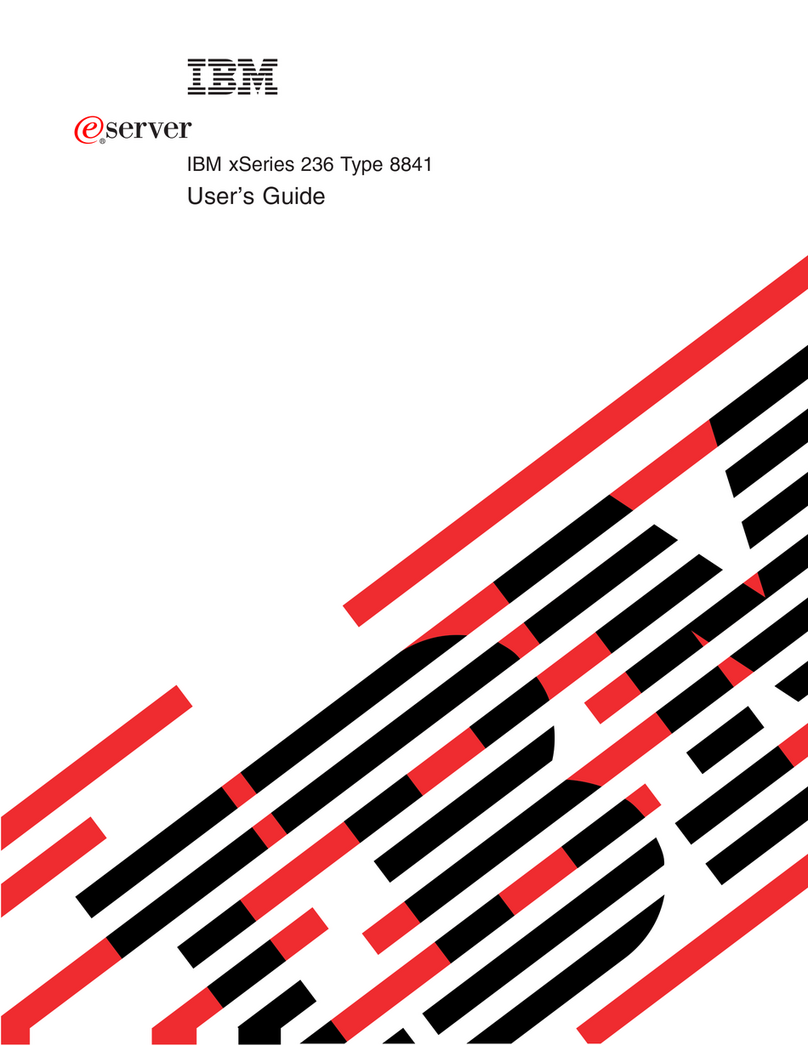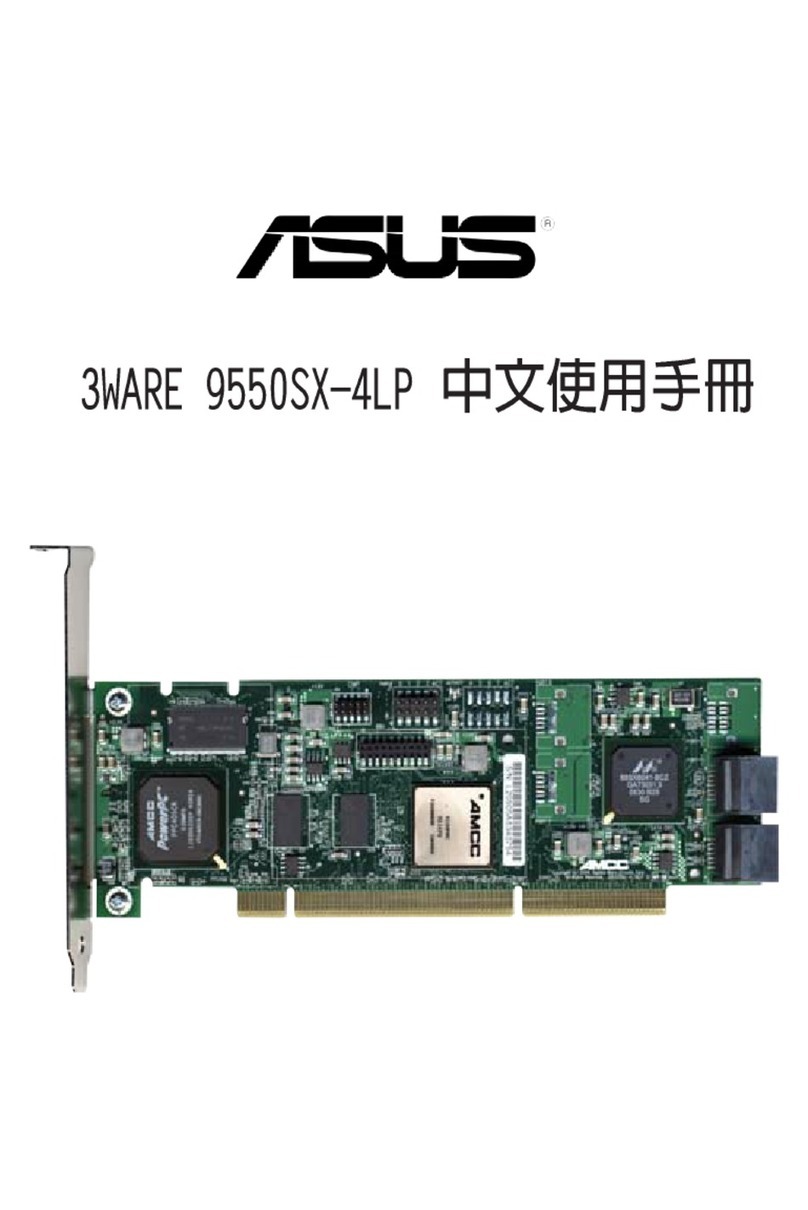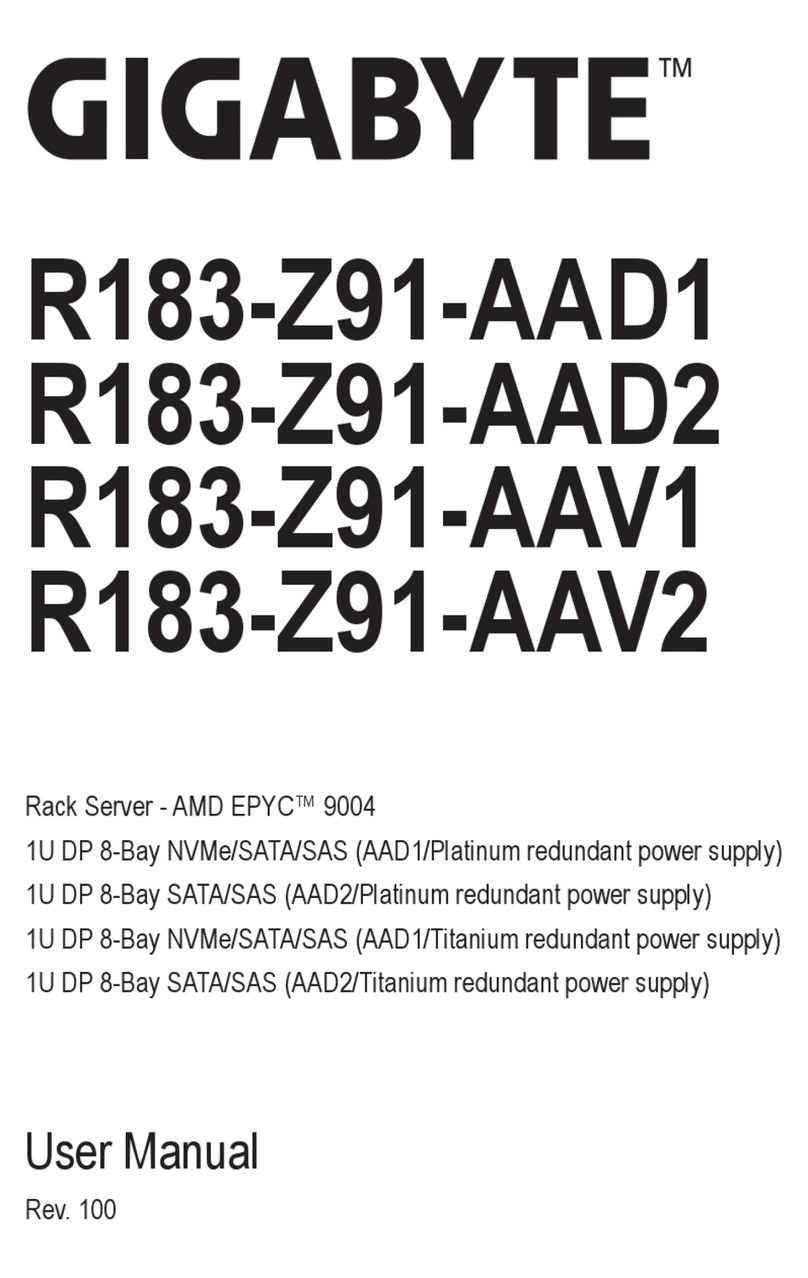TANDBERG D14049.04 Service manual

1
D14049.07
March 2010
Video
Communication
Server
ADMINISTRATOR
GUIDE
Software version X5.1
March 2010
Introduction Overview and
status
System
conguration
VCS
conguration
Zones and
neighbors
Clustering and
peers
Call
processing
Bandwidth
control
Firewall
traversal Appendices
Applications Maintenance

2
D14049.07
March 2010
Grey Headline (continued)
Introduction
The TANDBERG VCS ................................................................ 8
Overview .......................................................................... 8
VCS and the TANDBERG Total Solution............................... 8
VCS base applications ...................................................... 9
VCS Control ................................................................ 9
VCS Expressway™ ...................................................... 9
Standard features .......................................................... 10
Optional features ........................................................... 11
FindMe™ .................................................................. 11
Device Provisioning ................................................... 11
Dual Network Interfaces ............................................ 11
What’s new in this version? ............................................. 12
Usability enhancements ............................................ 12
FindMe™ / User Policy option key .............................. 12
Subzone registration policies ..................................... 12
Zone conguration .................................................... 12
Conference Factory generated alias ranges ................ 12
Advanced Media Gateway support ............................. 12
Far end camera control interworking .......................... 13
G.729 support for interworked calls ........................... 13
Advanced account security ........................................ 13
CRL checking for TLS connections to LDAP servers .... 13
HTTPS client certicate validation .............................. 13
Clustering ................................................................. 13
Hardware failure warnings ......................................... 13
Auditor account access level ..................................... 13
Remote account authentication over LDAP ................. 13
Starter Pack ............................................................. 13
Using this guide .................................................................... 14
Using the VCS ...................................................................... 15
Web interface ................................................................. 15
Installation and initial conguration ........................... 15
Using the web interface............................................. 15
Provisioning .................................................................... 29
Warnings ........................................................................ 30
Hardware........................................................................ 30
Event Log ....................................................................... 31
Conguration Log ............................................................ 39
System conguration
System conguration ............................................................ 41
System administration .................................................... 41
About the system name ........................................... 41
About administration access settings ....................... 41
Ethernet ......................................................................... 41
About Ethernet speed ............................................... 41
IP ................................................................................... 42
About IP protocols .................................................... 42
IPv4 to IPv6 gatewaying (interworking) ................. 42
External LAN interface .............................................. 42
About IP routes (static routes) ................................... 42
About LAN conguration ............................................ 42
About Dual Network Interfaces .................................. 42
About static NAT ....................................................... 42
Quality of Service (QoS) .................................................. 43
Supported mechanisms ............................................ 43
DNS ............................................................................... 43
About DNS servers ................................................... 43
About DNS settings................................................... 43
Time .............................................................................. 44
About the NTP server ................................................ 44
VCS time display ....................................................... 44
Login page ..................................................................... 44
SNMP............................................................................. 45
About SNMP ............................................................. 45
External manager............................................................ 45
About external managers .......................................... 45
Supported browsers .................................................. 15
Page features and layout ........................................... 16
Command line interface (CLI) ...........................................17
Installation and initial conguration ............................17
Command types .........................................................17
How CLI commands are shown in this guide ................17
Text entry ........................................................................17
Supported characters ................................................17
Case sensitivity .........................................................17
Overview and status
Overview page ...................................................................... 19
Status .................................................................................. 20
System information ......................................................... 20
Ethernet status ............................................................... 20
IP status ........................................................................ 21
Resource usage .............................................................. 21
Registrations by device ................................................... 22
Registrations by alias ...................................................... 22
Registration history ......................................................... 23
Registration details ......................................................... 23
Calls .............................................................................. 24
Call history ..................................................................... 24
Call summary ................................................................. 24
Searches ........................................................................ 25
Search history ................................................................ 25
Search details ................................................................ 25
Local Zone ..................................................................... 26
Zones............................................................................. 26
Links .............................................................................. 27
Pipes ............................................................................. 27
TURN relays .................................................................... 28
Presence ........................................................................ 28
OCS Relay ...................................................................... 29
TANDBERG VIDEO COMMUNICATION SERVER
ADMINISTRATOR GUIDE
Introduction Overview and
status
System
conguration
VCS
conguration
Zones and
neighbors
Clustering and
peers
Call
processing
Bandwidth
control
Firewall
traversal Appendices
Applications Maintenance
What’s in this manual?

3
D14049.07
March 2010
Grey Headline (continued)
Conguration ............................................................ 45
Logging .......................................................................... 46
About Event Log levels .............................................. 46
Setting the Event Log level ........................................ 46
About remote logging ................................................ 46
Enabling remote logging ............................................ 46
VCS conguration
H.323 .................................................................................. 48
H.323 overview .............................................................. 48
About H.323 on the VCS ........................................... 48
Using the VCS as an H.323 gatekeeper ..................... 48
H.323 endpoint registration ............................................ 48
Conguring H.323 ........................................................... 49
Enabling H.323 ......................................................... 49
Conguring H.323 ports ............................................ 49
Registration conict mode ......................................... 49
Time to live ............................................................... 49
Call time to live ......................................................... 49
Auto discover ............................................................ 49
Caller ID ................................................................... 49
SIP ....................................................................................... 50
SIP overview ................................................................... 50
About SIP on the VCS ................................................ 50
Using the VCS as a SIP registrar ................................ 50
Using the VCS as a SIP Presence Server .................... 50
Using the VCS as a SIP proxy server .......................... 50
Proxying registration requests ................................... 50
SIP endpoint registration ........................................... 50
Movi v2.0 (or later) clients ................................... 50
Conguring SIP ............................................................... 51
Enabling SIP ............................................................. 51
SIP registration expiry ............................................... 51
SIP registration proxy mode ....................................... 51
Zones and neighbors
Introduction .......................................................................... 62
Local Zone and subzones ...................................................... 63
Conguring the Local Zone and its subzones .................... 63
Bandwidth management ............................................ 63
Local Zone searches ................................................. 63
Traversal Subzone........................................................... 64
What are traversal calls? ........................................... 64
Conguring the Traversal Subzone ports .................... 64
Zones .................................................................................. 65
About zones ................................................................... 65
Neighbor zone ................................................................ 65
Traversal client zone ....................................................... 65
Traversal server zone ...................................................... 65
ENUM zone ..................................................................... 66
DNS zone ....................................................................... 66
Default Zone................................................................... 66
Zone conguration .......................................................... 67
TLS certicate verication of neighbor systems ......... 67
Connections to neighbor systems over TCP and TLS ... 67
SIP authentication trust ............................................ 67
Conguring zones ........................................................... 68
Conguring neighbor zones ............................................. 68
Conguring traversal client zones .................................... 69
Conguring traversal server zones ................................... 70
Conguring ENUM zones ..................................................71
Conguring DNS zones .....................................................71
Zone conguration: advanced settings ............................. 72
Zone conguration: pre-congured prole settings ............ 75
Dial plans ............................................................................. 76
Structuring your dial plan ................................................ 76
Flat dial plan ............................................................. 76
Structured dial plan .................................................. 76
Hierarchical dial plan ................................................ 76
SIP protocols and ports ............................................. 51
Session timers ......................................................... 51
SIP device interoperability ......................................... 51
SIP domains ................................................................... 51
Interworking ......................................................................... 52
Conguring interworking .................................................. 52
H.323 <-> SIP interworking mode .............................. 52
Enabling SIP endpoints to dial H.323 numbers ........... 52
Registration control .............................................................. 53
Registration overview ...................................................... 53
Endpoint registration ................................................. 53
Registrations on a VCS Expressway ........................... 53
MCU, gateway and Content Server registration ........... 53
Finding a VCS with which to register ........................... 54
SIP ..................................................................... 54
H.323................................................................. 54
Preventing automatic registrations ....................... 54
Device authentication ..................................................... 55
Device authentication using LDAP.................................... 56
Conguring the LDAP server directory ........................ 56
Conguring LDAP server settings .............................. 56
Authentication using a local database ............................. 57
Authenticating with external systems ............................... 57
Registering aliases ......................................................... 58
About alias registration ............................................. 58
Attempts to register using an existing alias ................ 58
Blocking registrations ............................................... 58
Allow and Deny Lists ....................................................... 59
About Allow and Deny Lists ....................................... 59
Activating use of Allow or Deny Lists .......................... 59
Removing existing registrations ................................. 59
Using the Allow and Deny Lists .................................. 60
TANDBERG VIDEO COMMUNICATION SERVER
ADMINISTRATOR GUIDE
Introduction Overview and
status
System
conguration
VCS
conguration
Zones and
neighbors
Clustering and
peers
Call
processing
Bandwidth
control
Firewall
traversal Appendices
Applications Maintenance
What’s in this manual?

4
D14049.07
March 2010
Grey Headline (continued)
Clustering and peers
Clustering overview ............................................................... 78
About clustering.............................................................. 78
About the conguration master .................................. 78
Cluster conguration ............................................................. 79
Conguring clusters ........................................................ 79
Setting up a cluster ................................................... 79
Maintaining a cluster ................................................. 79
Setting conguration for the cluster ..................... 79
Adding and removing peers from a cluster ............ 79
Cluster name ...................................................... 79
Changing the master peer ................................... 79
Monitoring the status of the cluster ..................... 79
Which conguration is not replicated? .............................. 80
Troubleshooting cluster replication problems ................... 80
Managing clusters and peers ................................................ 81
Sharing registrations across peers .................................. 81
Sharing bandwidth across peers ...................................... 81
Upgrades and downgrades .............................................. 81
Backup and restore ......................................................... 81
Clustering and FindMe .................................................... 82
Clustering and Presence ................................................. 82
Clustering and TMS ......................................................... 82
Cluster Subzone ............................................................. 83
Neighboring the local VCS to another VCS cluster ............. 83
Call processing
Introduction .......................................................................... 85
Search process .............................................................. 85
Dialing by address types ....................................................... 86
About the different address types ................................... 86
Dialing by IP address ...................................................... 86
Endpoints registered to a VCS Expressway ................. 86
Dialing by H.323 ID or E.164 alias ................................... 86
Conguring Call Policy using a CPL script ....................... 102
Viewing existing CPL script ...................................... 102
About CPL XSD les ................................................ 102
Uploading a CPL script ............................................ 102
Deleting an existing CPL script ................................ 102
Routing calls via the Advanced Media Gateway .................... 103
VCS and the Advanced Media Gateway .......................... 103
Conguring the VCS to use the AM gateway .............. 103
Usage features and limitations ................................ 103
Controlling which calls to route via the AM gateway .. 103
Conguring AM gateway policy rules ......................... 104
URI dialing .......................................................................... 105
Overview ...................................................................... 105
URI dialing without DNS .......................................... 105
URI dialing via DNS ................................................. 105
Enabling URI dialing via DNS ......................................... 105
URI resolution process using DNS ................................. 106
URI dialing via DNS for outgoing calls .............................107
URI dialing process ..................................................107
Adding and conguring DNS zones ............................107
Conguring search rules for DNS zones ....................107
Conguring DNS servers ..........................................107
URI dialing via DNS for incoming calls ............................ 108
Types of DNS records required ................................ 108
Incoming call process ............................................. 108
SRV record format ................................................. 108
Conguring H.323 SRV records ................................ 108
Conguring SIP SRV records .................................... 108
Example DNS record conguration ........................... 109
URI dialing and rewall traversal .................................... 109
Recommended conguration ................................... 109
ENUM dialing ...................................................................... 110
ENUM dialing process ................................................... 110
Enabling ENUM dialing .................................................. 110
Dialing by H.323 or SIP URI ............................................. 86
Dialing by ENUM ............................................................. 86
Hop counts ........................................................................... 87
About hop counts ........................................................... 87
Conguring hop counts.................................................... 87
Searches and transforms ...................................................... 88
Overview of searches and transforms .............................. 88
Zone searching and transform process ...................... 88
Pre-search transforms .................................................... 89
Pre-search transform process ................................... 89
Conguring pre-search transforms ............................. 90
Search conguration ...................................................... 91
Calls to unknown IP addresses .................................. 91
About unregistered endpoints .............................. 91
Calls to Unknown IP addresses settings ............... 91
Recommended conguration for rewall traversal 91
Fallback alias............................................................ 91
Zone searching and zone transforms ............................... 92
Examples ....................................................................... 94
Stripping @domain for dialing to H.323 numbers ........ 94
Examples ....................................................................... 95
Transforms for alphanumeric H.323 ID dial strings ..... 95
Combining match types and priorities ........................ 96
Always query a zone with original alias (no transforms) 96
Conguring a zone for incoming calls only .................. 96
Filter queries to a zone without transforming .............. 97
Allowing calls to IP addresses only if they come from
known zones ............................................................. 97
Query a zone for original and transformed alias .......... 98
Query a zone for two or more transformed aliases ...... 99
Call Policy........................................................................... 100
Call Policy and authentication ........................................ 100
Enabling Call Policy ....................................................... 101
Conguring basic Call Policy using the web interface ...... 101
TANDBERG VIDEO COMMUNICATION SERVER
ADMINISTRATOR GUIDE
Introduction Overview and
status
System
conguration
VCS
conguration
Zones and
neighbors
Clustering and
peers
Call
processing
Bandwidth
control
Firewall
traversal Appendices
Applications Maintenance
What’s in this manual?

5
D14049.07
March 2010
Grey Headline (continued)
ENUM dialing for outgoing calls ..................................... 111
Prerequisites .......................................................... 111
Process .................................................................. 111
ENUM dialing for outgoing calls ..................................... 112
Adding and conguring ENUM zones ........................ 112
Conguring matches for ENUM zones ....................... 112
Conguring transforms for ENUM zones ................... 112
Conguring DNS servers ......................................... 112
ENUM dialing for incoming calls ..................................... 113
Prerequisites .......................................................... 113
About DNS domains for ENUM ................................. 113
Conguring DNS NAPTR records .............................. 113
Call conguration ................................................................ 114
Call routed mode .......................................................... 114
Call loop detection mode .............................................. 114
Call IDs, Serial Numbers and Tags ....................................... 115
Identifying calls ............................................................ 115
Disconnecting calls ............................................................. 116
Limitations when disconnecting SIP calls ....................... 116
Bandwidth control
Bandwidth control overview ................................................. 118
Bandwidth control on the VCS ....................................... 118
Example network deployment ........................................ 118
Subzones ........................................................................... 119
About subzones ............................................................ 119
Subzone registration policy ...................................... 119
About the Traversal Subzone ......................................... 119
Traversal calls ........................................................ 119
About the Default Subzone ............................................ 119
Default links between subzones .................................... 119
Conguring subzones and membership rules .................. 120
Applying bandwidth limitations to subzones ................... 121
Bandwidth consumption of traversal calls ................ 121
Conguring the VCS as a traversal client .............................. 135
Conguring the VCS as a traversal server ............................ 136
Adding and conguring a traversal server zone ............... 136
Conguring traversal for endpoints ................................ 136
Conguring traversal server ports .................................. 137
Conguring the VCS as a TURN server ................................. 138
TURN services .............................................................. 138
About ICE ............................................................... 138
About TURN ............................................................ 138
TURN relay server ................................................... 138
Capabilities and limitations ..................................... 138
Conguring TURN services ...................................... 138
Applications
Conference Factory ............................................................. 140
Conguration ................................................................ 140
Presence .............................................................................141
Presence Server ............................................................141
Presence User Agent (PUA) ............................................ 142
Aggregation of presence information ....................... 142
FindMe presence .............................................. 142
Registration refresh period ...................................... 142
Conguring Presence .................................................... 143
Enabling and disabling Presence Services ................ 143
Presence Server expiration times ............................ 143
Viewing presence status ............................................... 144
Publishers .............................................................. 144
Presentities ........................................................... 144
Subscribers ............................................................ 144
OCS Relay .......................................................................... 145
Conguring OCS Relay ................................................... 145
Viewing OCS Relay status .............................................. 145
FindMe™ ............................................................................ 146
Overview ...................................................................... 146
Links .................................................................................. 122
Creating and editing links .............................................. 122
Default links ................................................................. 122
Pipes ................................................................................. 123
Creating and editing pipes ............................................. 123
Applying pipes to links .................................................. 124
Default bandwidth and downspeeding .................................. 125
Bandwidth control examples ............................................... 126
Example without a rewall ............................................. 126
Example with a rewall .................................................. 127
VCS Expressway subzone conguration .................... 127
VCS Control subzone conguration .......................... 127
Firewall traversal
Firewall traversal overview ................................................... 129
About Expressway™ ...................................................... 129
VCS as a rewall traversal client .................................... 129
VCS as a rewall traversal server ................................... 129
Quick guide to VCS traversal client - server conguration ...... 130
Firewall traversal protocols and ports .................................. 131
Expressway process ..................................................... 131
H.323 rewall traversal protocols .................................. 131
SIP rewall traversal protocols....................................... 131
Ports for initial connections from traversal clients .......... 132
Assent ports................................................................. 132
SIP ports ...................................................................... 132
H.460.18/19 ports ....................................................... 132
TURN ports ................................................................... 132
Ports for connections out to the public internet .............. 132
Firewall traversal and authentication ................................... 133
Authentication and NTP ................................................. 133
Other issues ....................................................................... 134
Firewall traversal and Dual Network Interfaces ............... 134
Firewall conguration .................................................... 134
TANDBERG VIDEO COMMUNICATION SERVER
ADMINISTRATOR GUIDE
Introduction Overview and
status
System
conguration
VCS
conguration
Zones and
neighbors
Clustering and
peers
Call
processing
Bandwidth
control
Firewall
traversal Appendices
Applications Maintenance
What’s in this manual?

6
D14049.07
March 2010
Grey Headline (continued)
What is FindMe? ..................................................... 146
How are devices specied? ..................................... 146
Process overview .................................................... 146
Who must do what before FindMe can be used? ....... 146
Recommendations when deploying FindMe .............. 146
Enabling FindMe on the VCS ...........................................147
Conguring FindMe ..................................................147
Caller ID ............................................................147
Device creation message ...................................147
Searching for FindMe accounts ......................................147
Principal devices ............................................................147
TANDBERG FindMe™ user guide .......................................... 148
About FindMe ............................................................... 148
FindMe user accounts ............................................. 148
Individual versus group FindMe ............................... 148
Accessing the FindMe home page ................................. 148
Conguring your FindMe user account ............................ 149
FindMe home page ................................................. 149
Dening device details ............................................ 150
Dening location details .......................................... 151
Provisioning (Starter Pack) .................................................. 152
Conguration ................................................................ 152
TMS Agent.......................................................................... 153
Overview ...................................................................... 153
FindMe™ ................................................................ 153
Device Provisioning ................................................. 153
TMS Agent account passwords ................................ 153
Maintenance
Upgrading software components ......................................... 155
Overview ...................................................................... 155
VCS software components ...................................... 155
Prerequisites .......................................................... 155
Backing up before upgrading ................................... 155
TLS encryption and CRL checking ............................ 165
Root account ................................................................ 166
Changing the root account password ....................... 166
Accessing the root account over SSH and Telnet ...... 166
Resetting passwords .................................................... 166
System administration access............................................. 167
Overview ...................................................................... 167
Security considerations ........................................... 167
Conguring administration access ........................... 167
Administration session timeout ............................... 167
Backup and restore ............................................................ 168
Creating a backup of your VCS data ............................... 168
Restoring a previous backup ......................................... 168
System snapshot ................................................................ 169
Creating a system snapshot .......................................... 169
Incident reporting ................................................................170
Warning: privacy-protected personal data ..................170
What information does the report contain? .....................170
Viewing incident reports .................................................171
Sending incident reports manually ..................................171
Removing sensitive information from the report ........171
Sending incident reports automatically ...........................171
Tools ...................................................................................172
Check pattern ................................................................172
Locate ...........................................................................172
Port usage .....................................................................173
Local VCS inbound ports ..........................................173
Local VCS outbound ports ........................................173
Remote listening ports .............................................173
Restarting, rebooting and shutting down ...............................174
Restoring default conguration .............................................175
Conguration items reset by DefaultValuesSet level 3 .....175
Conguration items reset by DefaultValuesSet level 2 .....176
Password encryption ............................................................178
Upgrading and option keys ...................................... 155
Installing and rebooting ........................................... 155
Upgrade procedure ....................................................... 156
Upgrading using secure copy (SCP/PSCP) ................ 156
Downgrade procedure ................................................... 156
Option keys ........................................................................ 157
Adding option keys using the web interface .................... 157
Adding option keys using the CLI ................................... 157
Security certicates ............................................................ 158
Enabling security .......................................................... 158
Trusted CA certicate .............................................. 158
Server certicate data ............................................. 158
Advanced account security .................................................. 159
Prerequisites .......................................................... 159
VCS functionality: changes and limitations ............... 159
Enabling advanced account security .............................. 159
Login accounts ................................................................... 160
Account authentication conguration ............................. 160
Administrator accounts ................................................. 161
Default administrator account ................................. 161
Additional administrator accounts ............................ 161
Administrator password security .............................. 161
Maintaining administrator accounts ............................... 161
Maintaining user accounts ............................................ 162
Creating user accounts ........................................... 162
Managing user accounts ......................................... 163
Conguring devices and locations ...................... 163
Conguring principal devices ............................. 163
Changing an account's password ....................... 163
Administrator and user groups ....................................... 164
Conguring administrator groups ............................. 164
Conguring user groups........................................... 164
Account authentication using LDAP ................................ 165
Conguring LDAP server settings ............................ 165
TANDBERG VIDEO COMMUNICATION SERVER
ADMINISTRATOR GUIDE
Introduction Overview and
status
System
conguration
VCS
conguration
Zones and
neighbors
Clustering and
peers
Call
processing
Bandwidth
control
Firewall
traversal Appendices
Applications Maintenance
What’s in this manual?

7
D14049.07
March 2010
Grey Headline (continued)
Appendices
CPL reference ..................................................................... 180
Overview of CPL on the VCS .......................................... 180
address-switch ............................................................. 180
address ................................................................. 180
eld........................................................................ 181
subeld .................................................................. 182
otherwise ..................................................................... 182
not-present ................................................................... 182
location ........................................................................ 183
rule-switch .................................................................... 183
proxy ........................................................................... 184
reject .......................................................................... 184
Unsupported CPL elements ........................................... 184
CPL examples ............................................................... 185
Call screening of authenticated users ...................... 185
Call screening based on alias .................................. 185
Call screening based on domain .............................. 186
Change of domain name.......................................... 186
Allow calls from locally registered endpoints only ..... 187
Block calls from Default Zone and Default Subzone .. 187
Restricting access to a local gateway ....................... 188
Using the address-switch node .......................... 188
Using the taa:rule-switch node ........................... 188
Redirecting failed calls based on status code........... 189
Reject attempts to subscribe to a presentity ............ 190
Regular expression reference .............................................. 191
Pattern variable reference ................................................... 192
VCS port reference ............................................................. 193
DNS conguration ............................................................... 196
Overview ...................................................................... 196
Verifying the SRV record .......................................... 196
Microsoft DNS server .................................................... 196
BIND 8 & 9 .................................................................. 196
LDAP conguration for device authentication ........................ 197
About the LDAP databases ............................................ 197
Downloading the H.350 schemas .................................. 197
Microsoft Active Directory ............................................ 197
Prerequisites ......................................................... 197
Installing the H.350 schemas .................................. 197
Adding H.350 objects ............................................ 198
Securing with TLS .................................................. 198
OpenLDAP .................................................................... 199
Prerequisites ......................................................... 199
Installing the H.350 schemas ................................. 199
Adding H.350 objects ............................................ 200
Securing with TLS .................................................. 200
Command reference - xConguration ................................... 201
Command reference - xCommand ........................................ 248
Command reference - xStatus ............................................. 265
Warnings ............................................................................ 284
Bibliography ....................................................................... 287
Glossary............................................................................. 289
Legal notices ...................................................................... 295
Contact information ............................................................ 296
TANDBERG VIDEO COMMUNICATION SERVER
ADMINISTRATOR GUIDE
Introduction Overview and
status
System
conguration
VCS
conguration
Zones and
neighbors
Clustering and
peers
Call
processing
Bandwidth
control
Firewall
traversal Appendices
Applications Maintenance
What’s in this manual?

Introduction
8
D14049.07
March 2010
Grey Headline (continued) TANDBERG VIDEO COMMUNICATION SERVER
ADMINISTRATOR GUIDE
Introduction Overview and
status
System
conguration
VCS
conguration
Zones and
neighbors
Clustering and
peers
Call
processing
Bandwidth
control
Firewall
traversal Appendices
Applications Maintenance
The TANDBERG VCS
F
IND
M
E
FIREWALL TRAVERSAL
MANAGEMENT SUITE
VIDEO
COMMUNICATION SERVER
CALL CONTROL
P
O
L
I
CE
N
E
T
W
O
R
K
S
T
A
N
D
A
R
D
S
C
O
M
P
L
I
A
N
T
3
G
S
I
P
/
H
.
3
2
3
,
H
.
3
2
0
M
A
N
A
G
E
D
C
O
N
C
I
E
R
G
E
I
P
I
S
D
N
T
H
I
R
D
P
A
R
T
Y
V
I
D
E
O
P
R
E
S
E
N
C
E
N
E
T
W
O
R
K
A
S
S
E
S
S
M
E
N
T
T
E
L
E
P
R
E
S
E
N
C
E
S
E
R
V
E
R
V
O
I
P
U
N
I
F
I
E
D
D
I
R
E
C
T
O
R
I
E
S
I
N
S
T
A
L
L
A
T
I
O
N
&
C
O
N
F
I
G
U
R
A
T
I
O
N
U
S
A
G
E
&
A
D
O
P
T
I
O
N
C
L
A
S
S
S
O
L
U
T
I
O
N
S
S
C
A
L
A
B
L
E
C
A
R
R
I
E
R
C
O
N
F
E
R
E
N
C
E
M
E
M
U
L
T
I
P
L
E
M
U
L
T
I
W
A
Y
C
O
N
T
R
O
L
U
N
I
T
S
V.35
Identify Requirements Build the Foundation Deploy the Right Solutions Transform your Organization
Make sure your next investment
supports your overall
communication strategy and is
interoperable with all existing and
future IT investments. Everything
should be easy to implement and
even easier to use.
Tame the network and centralize
call control and management
for all video assets. Ensure
everything is reliable and
scalable. As your deployment
strategy grows, your
foundation supports you
every step of the way.
One size does not fit all.
Choose the right video
endpoints and services to
support your end user
needs. Deliver the best
possible experience while
scaling video to everyone
in the organization.
Enable increased productivity
and richer collaboration.
Support teleworking
initiatives and reduce
your carbon footprint.
Gain a competitive
edge while
maximizing ROI.
©2008 XPLANE.com™
FINANCE
HEALTHCARE
EDUCATION
GOVERNMENT
MANUFACTURING
PUBLIC
SAFETY SMALL AND
MEDIUM BUSINESS
1 2 3 4
C
O
L
L
A
B
O
R
A
T
I
O
N
W
A
L
L
E
X
E
C
U
T
I
V
E
D
E
S
K
T
O
P
P
E
R
S
O
N
A
L
V
I
D
E
O
S
M
A
L
L
T
E
A
M
R
O
O
M
T
E
L
E
P
R
E
S
E
N
C
E
M
u
l
t
i
p
o
i
n
t
C
o
n
f
e
r
e
n
c
i
n
g
B
r
i
d
g
e
s
M
a
n
a
g
e
d
a
n
d
P
r
o
f
e
s
s
i
o
n
a
l
S
e
r
v
i
c
e
s
S
t
r
e
a
m
i
n
g
,
R
e
c
o
r
d
i
n
g
a
n
d
A
r
c
h
i
v
i
n
g
G
a
t
e
w
a
y
s
a
n
d
I
V
R
I
n
t
e
r
o
p
e
r
a
b
i
l
i
t
y
INDUSTRY
SOLUTIONS
The TANDBERG
Total Solution
TANDBERG delivers the most comprehensive and reliable total solution of video
products in the industry - including telepresence and high definition video, a full
portfolio of infrastructure products and MCUs, and the best video management
platform available. A TANDBERG solution-based approach means organizations
can add new standards-compliant technologies and capabilities, easily and
transparently, at any time - with no disruption to the end-user experience.
This translates into future-proof investments and an unparalleled video
experience for end users and IT professionals alike.
P
E
R
S
O
N
A
L
L
A
R
G
E
T
E
A
M
R
O
O
M
E
X
T
E
N
D
E
D
A
C
C
E
S
S
M
O
B
I
L
E
P
C
V
I
D
E
O
C
O
M
M
U
N
I
C
A
T
I
O
N
S
U
N
I
F
I
E
D
FIREWALL TRAVERSAL
PROVISIONING
DIRECTORIES
MONITORING
SCHEDULING
ROI
DIAGNOSTICS
VCS and the TANDBERG Total Solution
TANDBERG delivers the most comprehensive and reliable total
solution of video products in the industry - including telepresence
and high denition video, a full portfolio of infrastructure products
and MCUs, and the best video management platform available.
A TANDBERG solution-based approach means organizations can
add new standards-compliant technologies and capabilities, easily
and transparently, at any time - with no disruption to the end-user
experience.
This translates into future-proof investments and an unparalleled
video experience for end users and IT professionals alike.
The TANDBERG Video Communication Server
(VCS) enhances the video experience and
provides seamless communication between
SIP and H.323 devices utilizing IETF and
ITU standards. The VCS is the center of the
video communication network, and connects
all H.323 and SIP endpoints, infrastructure,
and management devices. The VCS provides
unrivaled scalability and redundancy to video
communications, and is integral to TANDBERG
interoperability with unied communications
and Voice over IP systems. The VCS can be
deployed with either the Control application
or the Expressway™ application, with various
optional packages including FindMe™, Dual
Network Interfaces and Device Provisioning.
Overview

9
D14049.07
March 2010
Grey Headline (continued) TANDBERG VIDEO COMMUNICATION SERVER
ADMINISTRATOR GUIDE
Introduction Overview and
status
System
conguration
VCS
conguration
Zones and
neighbors
Clustering and
peers
Call
processing
Bandwidth
control
Firewall
traversal Appendices
Applications Maintenance
The TANDBERG VCS
VCS Control
The VCS Control provides internal video control and administration for all SIP and H.323 devices.
It is normally deployed within your wide area network with endpoints that are behind the same
rewalls or NAT devices.
The VCS Control replaces the need to have separate H.323 gatekeeper, SIP registrar and H.323 -
SIP gateway servers.
VCS base applications
VCS Expressway™
The VCS Expressway provides standards-based rewall traversal for SIP and H.323 devices allowing
secure rewall traversal of any rewall or NAT device. As well as all the functionality of a VCS
Control, it also provides registration of traversal-enabled devices and can act as a standards-based
TURN server.
The VCS Expressway is normally deployed outside of your rewall or within the DMZ.

10
D14049.07
March 2010
Grey Headline (continued)
Standard features
• 2500 endpoint registrations
• H.323 gatekeeper
• SIP Proxy/Registrar
• SIP Presence Server
• SIP Presence User Agent
• SIP and H.323 support, including SIP/H.323 gatewaying
• IPv4 and IPv6 support, including IPv4/IPv6 gatewaying
• QoS tagging
• Bandwidth management on both a per-call and a total usage basis, congurable separately for
calls within the local subzones and to external systems and zones
• Automatic downspeeding option for calls that exceed the available bandwidth
• URI and ENUM dialing via DNS, enabling global connectivity
• Up to 500 non-traversal calls
• Up to 100 traversal calls
• 1000 external zones with up to 2000 matches
• 1000 subzones and supporting up to 3000 membership rules
• Flexible zone conguration with prex, sufx and regex support
• Can function as a standalone VCS or be neighbored with other systems such as VCSs, Border
Controllers, gatekeepers and SIP proxies
• n+1 redundancy, can be part of a cluster of up to 6 VCSs for increased capacity and redundancy
• Intelligent Route Director for single number dialing and network failover facilities
• Optional endpoint authentication
• Control over which endpoints are allowed to register
• Call Policy (also known as Administrator Policy) including support for CPL
• Can be managed with TANDBERG Management Suite 12.5 or later
• AD authentication for administrators of the VCS
• Pre-congured defaults for Microsoft Ofce Communications Server (OCS) 2007 neighbor zones
• Pre-congured defaults for Cisco Call Manager neighbor zones
• Pre-congured defaults for Nortel Communication Server neighbor zones
• Embedded setup wizard using a serial port for initial conguration
• System administration using a web interface or RS-232, Telnet, SSH, and HTTPS
TANDBERG VIDEO COMMUNICATION SERVER
ADMINISTRATOR GUIDE
Introduction Overview and
status
System
conguration
VCS
conguration
Zones and
neighbors
Clustering and
peers
Call
processing
Bandwidth
control
Firewall
traversal Appendices
Applications Maintenance
The TANDBERG VCS

11
D14049.07
March 2010
Grey Headline (continued)
The following features are available on the VCS by the purchase and installation of the appropriate
option key:
FindMe™
A unique industry solution that gives individual video users a single alias on which they can be
contacted regardless of location. Users have the ability to log on to a Web-based interface and
control where and how they are contacted. The FindMe feature also includes support for Microsoft
Ofce Communications Server (OCS) 2007, enabling FindMe aliases to register as Microsoft Ofce
Communicator (MOC) clients, and MOC clients to view the presence status of FindMe aliases.
Device Provisioning
The Device Provisioning option key allows VCS to provision endpoints with conguration information
on request and to supply endpoints with phone book information. (Endpoints including TANDBERG
Movi v2.0 or later, and E20 v2.1 or later can request to be provisioned.) All conguration and phone
book information is managed in TMS, and distributed to the clients through the TMS Agent running
on the VCS. The TMS Agent on the VCS also provides TMS with the provisioned client’s status.
There is no conguration associated with Device Provisioning on the VCS – it is either on or off,
depending on whether or not the option key is installed. See the TMS documentation and the
TANDBERG Provisioning Deployment Guide [26].
Dual Network Interfaces
Enables the LAN 2 Ethernet port on the VCS Expressway, allowing you to have a secondary IP
address for your VCS.
This option also includes support for deployments where a VCS Expressway is located behind a
static NAT device, allowing it to have separate public and private IP addresses.
This conguration is intended for high-security deployments where the VCS Expressway is located in
a DMZ between two separate rewalls on separate network segments.
Optional features
TANDBERG VIDEO COMMUNICATION SERVER
ADMINISTRATOR GUIDE
Introduction Overview and
status
System
conguration
VCS
conguration
Zones and
neighbors
Clustering and
peers
Call
processing
Bandwidth
control
Firewall
traversal Appendices
Applications Maintenance
The TANDBERG VCS

12
D14049.07
March 2010
Grey Headline (continued)
The following features have been introduced in version X5.1 of
the VCS software:
Usability enhancements
Many usability improvements have been made, including:
• Description elds for conguration items: a free-format
description can be specied for the following conguration
items: transforms, Allow List and Deny List patterns, search
rules, subzone membership rules.
When viewing the summary list of these items the description
is displayed as a mouse-over tooltip.
• Enable and disable conguration items: transforms, search
rules and subzone membership rules can be individually
enabled and disabled. This makes it easier to make or test
conguration changes.
Previously, conguration items would have to be deleted and
re-created as necessary. The enabled or disabled state is
clearly shown on the summary list pages.
• "Add sufx" and "add prex" transform options: new pre-
search transform pattern behavior options let you add a prex
or sufx to the matching alias. Previously, regular expressions
would have been required to do this.
• Consistent create and modify behavior for conguration
items: for conguration where multiple items can be dened
(for example, Allow List patterns, search rules and so on) the
create and modify behavior has been made consistent so that
you are always returned to the summary list page after saving
your changes.
Additionally, new search rules, subzone membership rules,
subzones and zones are all created in a single step. Previously
you had to specify some of the conguration values when
creating the item, and then return to the edit page to specify
the remainder of the values.
• "Please select" in drop-down elds: when creating
conguration items some of the default values presented in
drop-down selection elds have been replaced with a "please
select" value. This helps prevent potentially undesirable
default values being selected by mistake.
• Improved ltering options for Event Log and Conguration
Log: advanced ltering options let you include or exclude
specic words or phrases when ltering the view of the Event
Log and the Conguration Log.
• OCS Relay status: colored status icons make the difference
between the online and ofine OCS Relay status more distinct.
• Conguration warnings: more warnings are raised for common
misconguration scenarios, for example if a clustered VCS has
H.323 disabled, or if default links are not present.
FindMe™ / User Policy option key
• The User Policy option key has been renamed as the FindMe™
option key.
• "FindMe accounts" and "FindMe groups" are now referred to
as "user accounts" and "user groups" respectively.
Subzone registration policies
• In addition to using Allow Lists and Deny Lists, registrations
can be controlled at the subzone level. Each subzone can be
congured to allow or deny registrations assigned to it via
the subzone membership rules. See the subzones section for
more information.
• Up to 3000 subzone membership rules (previously 2000) can
be congured across all subzones.
Zone conguration
• TLS authentication: the VCS can perform certicate
verication of neighbor zones when communicating over TLS.
Mutual authentication can be performed with neighbor VCSs.
• TLS default transport type: TLS is the default SIP transport
type when setting up new neighbor, traversal client and
traversal server zones.
• SIP authentication trust: the VCS can be congured to trust
incoming SIP messages from specied neighbor zones, rather
than challenge them. This applies even if device authentication
is enabled on the VCS.
• Accept proxied registrations: controls whether proxied SIP
registrations routed through a neighbor, traversal client or
traversal server zone are accepted.
• Nortel Communication Server 1000 zone prole: the VCS can
automatically congure the settings required for connections
to a Nortel Communication Server 1000.
• Separate authentication credentials per traversal client
zone: each traversal client zone species its own username
and password for authentication with the traversal server. This
allows a traversal client VCS to connect to one or more service
providers.
See the zone conguration section for more information.
Note that the existing Outbound connection credentials
username and password are still used for connections to all
other (non traversal server) external systems.
Conference Factory generated alias ranges
• The upper and lower range limits of the numeric portion of the
generated alias can be specied.
• The numeric portion of the generated alias will pad with
leading zeroes to maintain a constant length, for example a
range of 10-999 will generate aliases 010 through 999.
Advanced Media Gateway support
The Advanced Media Gateway (AM gateway) provides support
for transcoding between standard codecs (such as H.264)
and Microsoft RT Video to allow high denition calls between
Microsoft Ofce Communicator (MOC) clients and TANDBERG
endpoints.
• Advanced Media Gateway zone prole: automatically
congures the VCS with the zone settings required for
connection to an AM gateway.
• Policy rules: ability to dene policy rules to control whether
all or only selected calls to or from MOC clients are diverted
through the AM gateway.
See VCS and the Advanced Media Gateway for more information.
What’s new in this version?
TANDBERG VIDEO COMMUNICATION SERVER
ADMINISTRATOR GUIDE
Introduction Overview and
status
System
conguration
VCS
conguration
Zones and
neighbors
Clustering and
peers
Call
processing
Bandwidth
control
Firewall
traversal Appendices
Applications Maintenance
The TANDBERG VCS

13
D14049.07
March 2010
Grey Headline (continued)
Far end camera control interworking
The VCS supports far end camera control (FECC) when
interworking calls between SIP and H.323 endpoints.
G.729 support for interworked calls
The G.729 codec is supported for interworked calls.
Advanced account security
An Advanced account security option key enables advanced
security features and restrictions for high-security installations.
Contact your TANDBERG support representative for more
information about this feature.
CRL checking for TLS connections to LDAP servers
Certicate revocation lists (CRLs) can be uploaded and used to
verify certicates presented by an LDAP server to the VCS when
forming a TLS connection. See Conguring LDAP server settings
for more information.
HTTPS client certicate validation
• The VCS web server can be congured to request a valid client
certicate before establishing an HTTPS session with a client
system (typically a web browser).
• Client certicate revocation lists can be uploaded and used to
verify the client certicate.
See Security certicates for more information.
Clustering
• Improved resilience: cluster conguration replication is more
resilient to network delay.
• TURN server: relay allocation requests are redirected to other
cluster peers if the rst VCS's relays are fully allocated.
Hardware failure warnings
Improved hardware failure detection, warnings and status display.
Auditor account access level
An Auditor access level can be assigned to administrator
accounts and groups. Users with the Auditor privilege can only
access the Overview, Event Log and Conguration Log pages.
Remote account authentication over LDAP
The LDAP server address of the remote directory service can be
specied as a DNS SRV record, thus allowing multiple (primary
and backup) servers to be specied.
Starter Pack
The Starter Pack option key is only available as a pre-congured
factory setting. It is designed for single box deployments and
provides basic device provisioning for registered Movi users,
without the need for TMS. It supports device authentication and
supplies phone book information to provisioned devices.
The Starter Pack includes the following features:
• Expressway
• FindMe
It has the following license restrictions:
• 50 registrations
• 5 calls (any combination of traversal and non-traversal calls)
Note that installing additional call license option keys will have no
effect while the Starter Pack option key is present.
See Provisioning (Starter Pack) for more information.
What’s new in this version? (continued)
The TANDBERG VCS TANDBERG VIDEO COMMUNICATION SERVER
ADMINISTRATOR GUIDE
Introduction Overview and
status
System
conguration
VCS
conguration
Zones and
neighbors
Clustering and
peers
Call
processing
Bandwidth
control
Firewall
traversal Appendices
Applications Maintenance

14
D14049.07
March 2010
Grey Headline (continued) TANDBERG VIDEO COMMUNICATION SERVER
ADMINISTRATOR GUIDE
Introduction Overview and
status
System
conguration
VCS
conguration
Zones and
neighbors
Clustering and
peers
Call
processing
Bandwidth
control
Firewall
traversal Appendices
Applications Maintenance
Using this guide
This Administrator Guide is provided to help you make the best use of your TANDBERG VCS.
Your approach to this documentation depends on what you want to do and how much you already
know.
The Administrator Guide has been divided into several sections, each providing different
information. In some places information is duplicated between sections to let you have all the
relevant information in one place.
This document does not have an index. This is intentional; if the Table of contents does not direct
you to the information you need, you can use the Find function in Adobe Reader to search the text
for keywords.
Note that the Administrator Guide describes a fully equipped version of the VCS. Your version may
not have all the described extensions installed.
Our main objective with this Administrator Guide is to address your goals and needs. Please let us
know how well we succeeded!
How to use this Administrator Guide
Typographical conventions
Most conguration tasks on the VCS can be performed by using either the web interface or a
command line interface (CLI). This guide describes how to use both methods.
Web interface
In this guide, instructions for performing a task using the web interface are shown in the format:
• Menu > Submenu
followed by the Name of the page that you will be taken to.
Command line interface (CLI)
In this guide, instructions for performing a task using the command line interface (CLI) are shown in
the format:
• xConguration <Element> <SubElement>
• xCommand <Command>
These are meant as a reference only. Each command is hyperlinked to the Command reference
table at the back of this guide; clicking on the hyperlink will take you to the appropriate section
of the table showing all the available sub-elements, parameters and valuespaces for the given
command.
Note that:
• Typing the given xConguration path into the CLI will return a list of values currently
congured for that element (and sub-elements where applicable).
• Typing the given xConguration path into the CLI followed by a ? will return information about
the usage for that element and sub-elements.
• Typing the given xCommand command into the CLI with or without a ? will return information
about the usage of that command.

15
D14049.07
March 2010
Grey Headline (continued) TANDBERG VIDEO COMMUNICATION SERVER
ADMINISTRATOR GUIDE
Introduction Overview and
status
System
conguration
VCS
conguration
Zones and
neighbors
Clustering and
peers
Call
processing
Bandwidth
control
Firewall
traversal Appendices
Applications Maintenance
Using the VCS
Web interface
Installation and initial conguration
Full installation and initial conguration instructions for the VCS
are contained in the TANDBERG VCS Getting Started Guide [28}.
Using the web interface
To use the web interface:
1. Open a browser window and in the address bar type either:
•
the IP address of the system
•
the FQDN of the system
2. Click Administrator Login.
3. Enter a valid administrator username and password and click
Login. (See the Login accounts section for details on setting
up administrator accounts.)
You are presented with the Overview page.
When logging in using the VCS web interface, you may
receive a warning message regarding the VCS's security
certicate. This can safely be ignored.
How page navigation is shown in this guide
In this Administrator Guide, instructions for navigating the web
interface are shown in the format:
• Menu option1 > Menu option2
followed by the Name of the page that you will be taken to in
order to perform a task.
Supported browsers
The VCS web interface is designed for use with Internet
Explorer 6 or later, and Firefox 2 or later. It may work with Opera
and Safari, but you could encounter unexpected behavior.
Javascript and cookies must be enabled to use the VCS web
interface.

16
D14049.07
March 2010
Grey Headline (continued) TANDBERG VIDEO COMMUNICATION SERVER
ADMINISTRATOR GUIDE
Introduction Overview and
status
System
conguration
VCS
conguration
Zones and
neighbors
Clustering and
peers
Call
processing
Bandwidth
control
Firewall
traversal Appendices
Applications Maintenance
Using the VCS
Web interface
Page features and layout
These are the features that can be found on
some or all of the web interface pages.
Note that you cannot change conguration
settings if your admin account is read-only.
Log out
This icon appears on the top right corner
of every page. Clicking on this icon ends your
administrator session.
Manual
This icon appears on the top right corner
of every page. Clicking on this icon takes
you directly to the latest version of the VCS
Administrator Guide on the TANDBERG web
site.
Information
This icon appears to the right of most
input elds in the web interface.
Clicking on this icon activates the Information
Box.
Page name and Location
Every page shows the page name and the
menu path to that page. Each part of the menu
path is a link; clicking on any of the higher level
menu items takes you to that page.
System Warning
This icon appears on the top right
corner of every page when there is a system
warning in place. Click on this icon to go to the
Warnings page which gives information about
the warning and its suggested resolution.
Information box
An information box appears on the
conguration pages whenever you either click
on the Information icon or click inside a eld.
This box gives you information about the
particular eld, including where applicable the
valid ranges and default value.
To close the information box, click on the X at
its top right corner.
System Information
The name of the user currently logged in, the
system name (or LAN 1 IPv4 address if no
system name is congured), local system time,
hardware serial number and VCS software
version are shown at the bottom of the page.
Sorting Columns
Click on column headings to sort the
information in ascending and descending order.
Select All and Unselect All
Use these buttons to select and unselect all
items in the list.
Status
On conguration pages, this section shows
you the current status of the items you are
conguring.
Note that some conguration changes require
a restart to take effect, so if you have changed
the conguration but not yet restarted this
shows the existing (unchanged) status.
Information bar
The VCS provides you with feedback in
certain situations, for example when settings
have been saved or when you need to take
further action. This feedback is given in a
yellow information bar at the top of the page.
Help
This icon appears on the top right corner
of every page. Clicking on this icon opens a
new browser window with help specic to the
page you are viewing. It gives an overview of
the purpose of the page, and introduces any
concepts congured from the page.

17
D14049.07
March 2010
Grey Headline (continued) TANDBERG VIDEO COMMUNICATION SERVER
ADMINISTRATOR GUIDE
Introduction Overview and
status
System
conguration
VCS
conguration
Zones and
neighbors
Clustering and
peers
Call
processing
Bandwidth
control
Firewall
traversal Appendices
Applications Maintenance
Using the VCS
Supported characters
The VCS supports the following characters when entering text in
the CLI and web interface:
• the letters A-Z and a-z
• decimal digits ( 0-9 )
• underscore ( _ )
• minus sign / hyphen ( - )
• equals sign ( = )
• plus sign ( + )
• at sign ( @ )
• comma ( , )
• period/full stop ( . )
• exclamation mark ( ! )
• spaces
• FindMe account names additionally allow the use of all
uppercase and lowercase Unicode characters
The following characters are specically not allowed:
• tabs
• angle brackets ( < and > )
• ampersand ( & )
• caret ( ^ )
Note that some specic text elds have different restrictions and
these are noted in the relevant sections of this guide, including:
• Administrator and user groups
Case sensitivity
Text items entered through the CLI and web interface are case
insensitive.
The only exception is passwords which are case sensitive.
Command line interface (CLI)
Installation and initial conguration
Full installation and initial conguration instructions for the VCS
are contained in the TANDBERG VCS Getting Started Guide [28}.
Using the CLI
The command line interface (CLI) is available by default over
SSH and through the serial port. Access using Telnet can also be
enabled.
To use the CLI:
1. Start a SSH or Telnet session.
2. Enter the IP address or FQDN of the VCS.
3. Login with a username of admin and your system password.
You will see a screen similar to that shown below. You can now
start using the CLI by typing the appropriate commands.
Command types
Commands are divided into different groups:
xStatus These commands return information
about the current status of the system.
Information such as current calls and
registrations is available through this
command group.
xConguration These commands allow you to add and
edit single items of data such as IP
address and zones.
xCommand These commands allow you to add and
congure items and obtain information.
xHistory These commands provide historical
information about calls and registrations.
xFeedback These commands provide information
about events as they happen, such as
calls and registrations.
See the Command reference Appendix for a full description of
commands available on the VCS.
How CLI commands are shown in this guide
In this guide, instructions for performing a task using the CLI are
shown in the format:
• xConguration <Element> <SubElement>
• xCommand <Command>
These are meant as a reference only. Each command is
hyperlinked to the Command reference table at the back of this
guide; clicking on the hyperlink takes you to the appropriate
section of the table showing all the available sub-elements,
parameters and valuespaces for the given command.
Note that:
• Typing the given xConguration path into the CLI returns a
list of values currently congured for that element (and sub-
elements where applicable).
• Typing the given xConguration path into the CLI followed
by a ? returns information about the usage for that element
and sub-elements.
• Typing the given xCommand command into the CLI with or
without a ? returns command usage information.
Text entry

18
D14049.07
March 2010
Grey Headline (continued)
This section describes the information that appears on the Overview page and all the
pages under the Status menu of the web interface.
These pages provide information on the current status and conguration of the VCS.
Overview and status
TANDBERG VIDEO COMMUNICATION SERVER
ADMINISTRATOR GUIDE
Introduction Overview and
status
System
conguration
VCS
conguration
Zones and
neighbors
Clustering and
peers
Call
processing
Bandwidth
control
Firewall
traversal Appendices
Applications Maintenance

19
D14049.07
March 2010
Grey Headline (continued) TANDBERG VIDEO COMMUNICATION SERVER
ADMINISTRATOR GUIDE
Introduction Overview and
status
System
conguration
VCS
conguration
Zones and
neighbors
Clustering and
peers
Call
processing
Bandwidth
control
Firewall
traversal Appendices
Applications Maintenance
Overview page
The Overview page summarizes the current conguration and status of your VCS.
The Overview page opens automatically when you rst log on to the web interface. You can also access it at any time by clicking on the Overview menu at the top left of any page.
Many of the items on this page are congurable, and contain links to the page where they can be congured. For example, clicking on System name will take you to the System administration page,
from where you can congure the system name.
The Overview page displays the following information:
System information
System name The name that has been assigned to the VCS.
Up time The amount of time that has elapsed since the system last restarted.
Software version The version of software that is currently installed on the VCS.
IPv4 address The VCS’s IPv4 address(es).
IPv6 address The VCS’s IPv6 address(es).
Options The maximum number of calls and registrations, and the availability of additional VCS features such as TURN Relays, FindMe™, Device Provisioning and Dual Network
Interfaces, are controlled through the use of option keys. This section shows all the options that are currently installed on the VCS.
Resource Usage
Traversal calls Current: The number of traversal calls going through the VCS at this moment.
Max (peak): The highest number of concurrent traversal calls handled by the VCS since it was last restarted.
Total: The total number of traversal calls handled by the VCS since it was last restarted.
See the Traversal calls section for details on what constitutes a traversal call.
Non-traversal calls Current: The number of non-traversal calls going through the VCS at this moment.
Max (peak): The highest number of concurrent non-traversal calls handled by the VCS since it was last restarted.
Total: The total number of non-traversal calls handled by the VCS since it was last restarted.
Registrations Current: The number of endpoints registered to the VCS at this moment.
Max (peak): The highest number of endpoints concurrently registered to the VCS since it was last restarted.
Total: The total number of registrations on the VCS since it was last restarted.
TURN relays
(VCS Expressway only)
Current: The number of active TURN relays at this moment.
Max (peak): The highest number of concurrently active TURN relays since the VCS was last restarted.
Total: The total number of TURN relays allocated on the VCS since it was last restarted.
Overview page

20
D14049.07
March 2010
Grey Headline (continued)
The System information page provides details of the software, hardware, and time settings of the
VCS.
To view the System information page:
• Status > System > Information
Some of the items on this page are congurable, and contain links to the page where they
can be congured. For example, clicking on Software options will take you to the Option
keys page, from where you can install new optional features.
The page displays the following information:
System information
System name The name that has been assigned to the VCS.
Product This will be TANDBERG VCS.
Software version The version of software that is currently installed on the VCS.
Software build The build number of this software version.
Software release
date
The date on which this version of the software was released.
Software name The internal TANDBERG reference number for this software release.
Software options The maximum number of calls, and the availability of additional VCS
features such as FindMe™, Device Provisioning and Dual Network
Interfaces, are controlled through the use of option keys. This section
shows all the optional features currently installed on the VCS.
Hardware version The version number of the hardware on which the VCS software is installed.
Hardware serial
number
The serial number of the hardware on which the VCS software is installed.
Time Information
Up time The amount of time that has elapsed since the system last restarted.
System time (UTC) The time as determined by the NTP server.
If no NTP server has been congured, this will show Time Not Set.
Time zone The time zone that has been congured on the Time page.
Local time If an NTP server has been congured, the system time in local time (UTC
adjusted according to the local time zone) is shown.
If no NTP server has been congured, the time according to the VCS’s
operating system is shown.
System information
The Ethernet status page provides details of the MAC address and Ethernet speed settings of the
VCS.
To view the Ethernet status page:
• Status > System > Ethernet
The page displays the following information for the LAN 1 port and, if the Dual Network Interfaces
option key has been installed, the LAN 2 port:
MAC address The MAC address of the VCS’s Ethernet device for that LAN port.
Speed The speed of the connection between the LAN port on the VCS and the
Ethernet switch.
Ethernet status
TANDBERG VIDEO COMMUNICATION SERVER
ADMINISTRATOR GUIDE
Introduction Overview and
status
System
conguration
VCS
conguration
Zones and
neighbors
Clustering and
peers
Call
processing
Bandwidth
control
Firewall
traversal Appendices
Applications Maintenance
Status
Table of contents
Other TANDBERG Server manuals
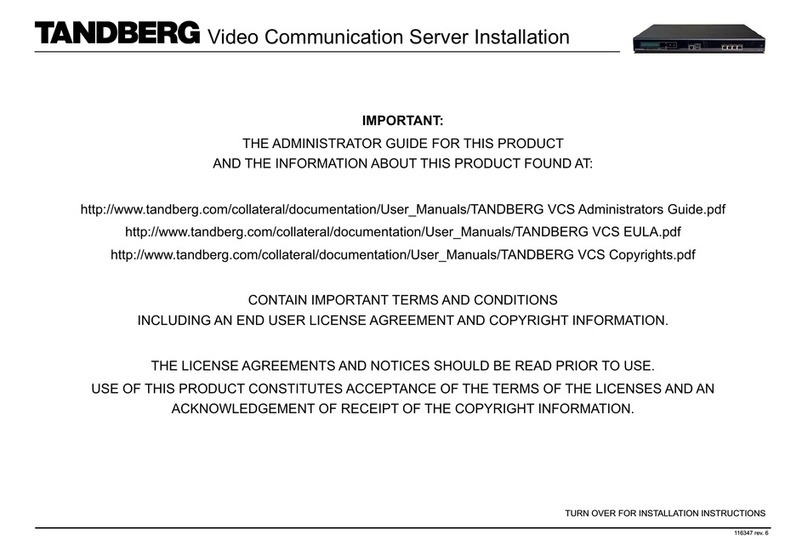
TANDBERG
TANDBERG Video Communication Server 116347 User manual
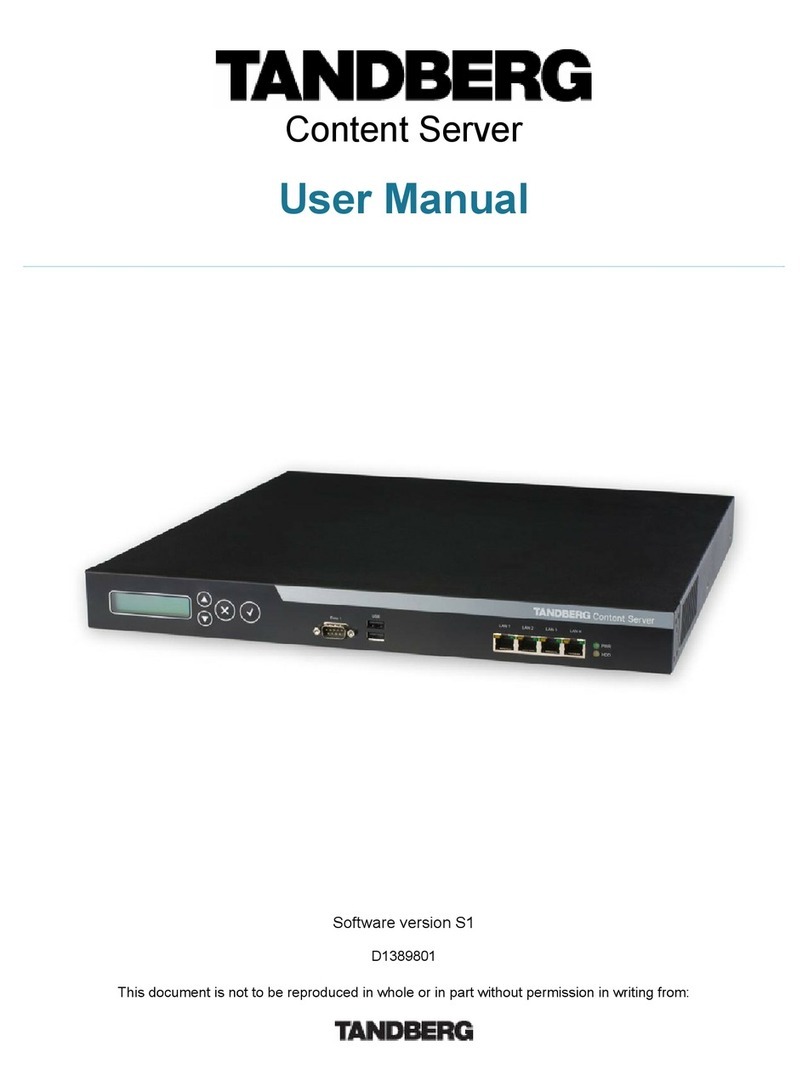
TANDBERG
TANDBERG D1389801 User manual
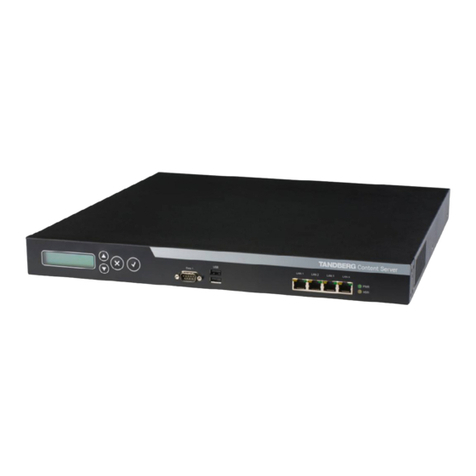
TANDBERG
TANDBERG D1389801 User manual
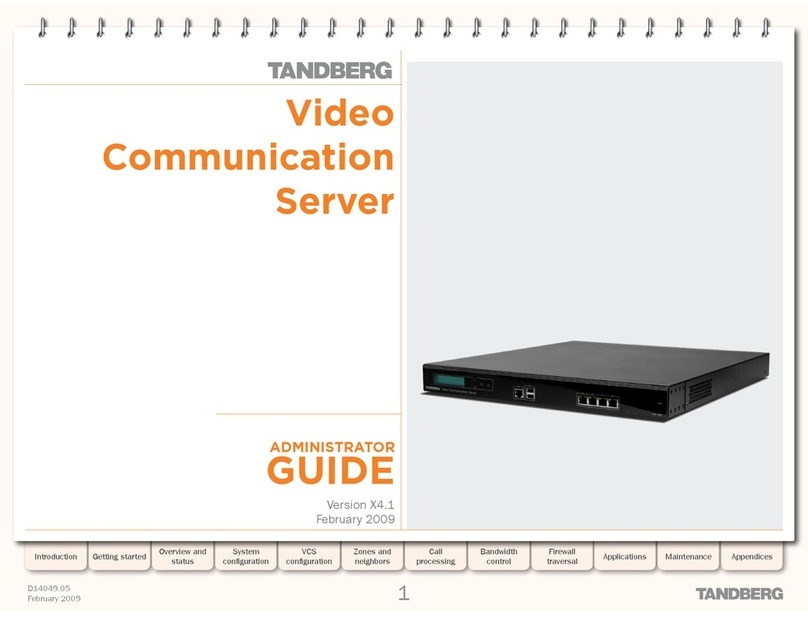
TANDBERG
TANDBERG Video Communication Server Service manual
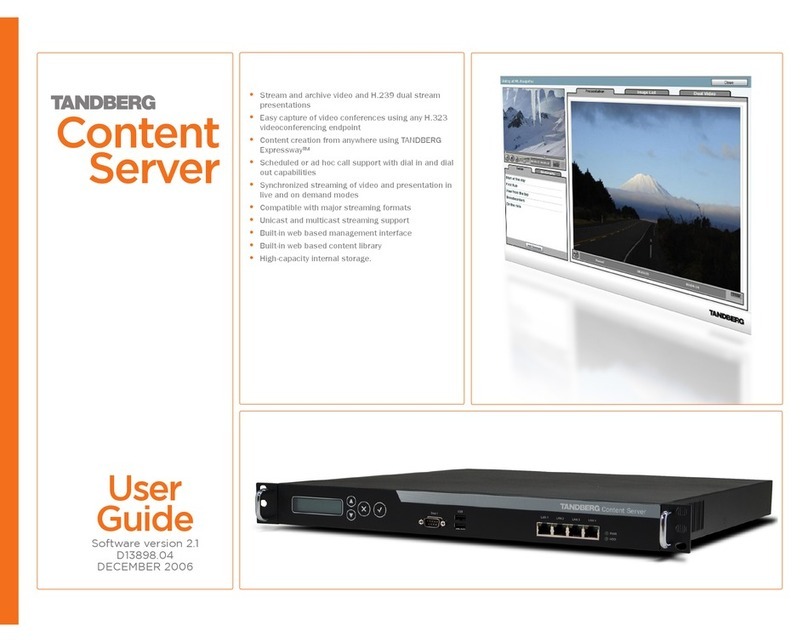
TANDBERG
TANDBERG CONTENT SERVER D13898.04 User manual
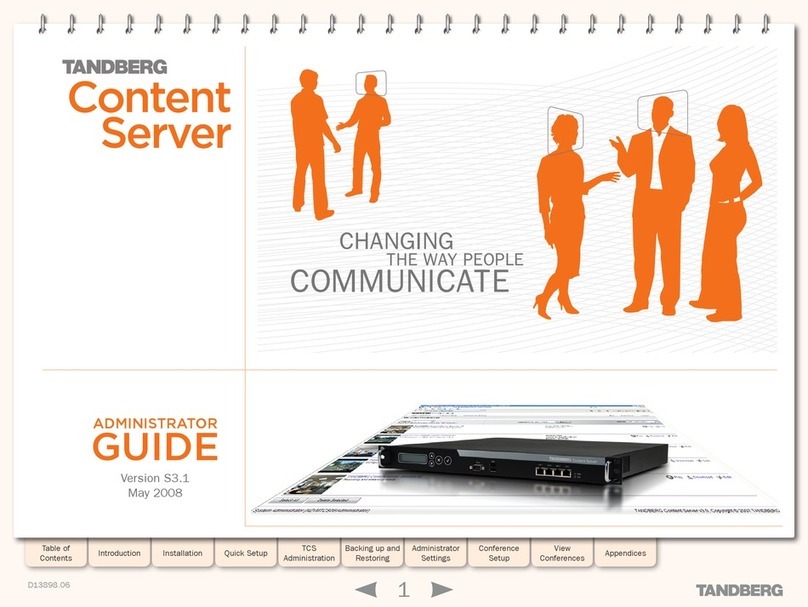
TANDBERG
TANDBERG S3.1 Service manual

TANDBERG
TANDBERG VCS Instruction Manual
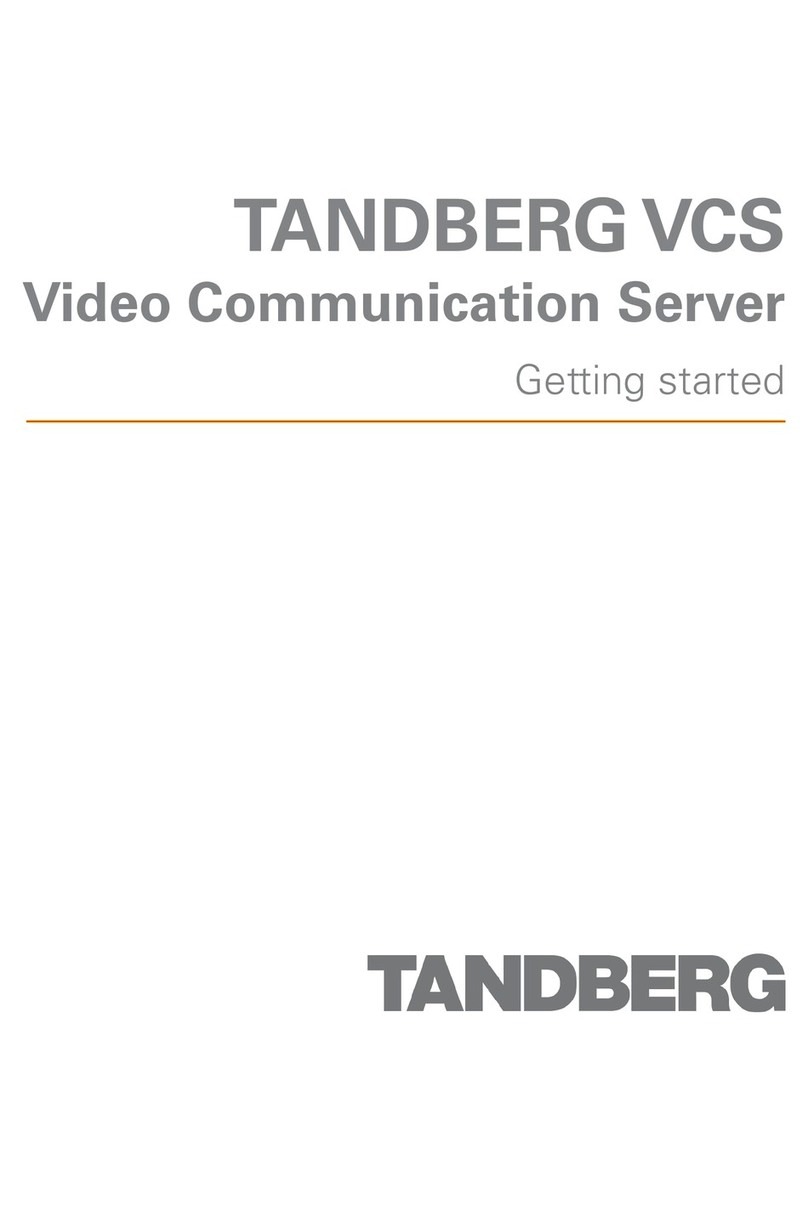
TANDBERG
TANDBERG VCS User manual
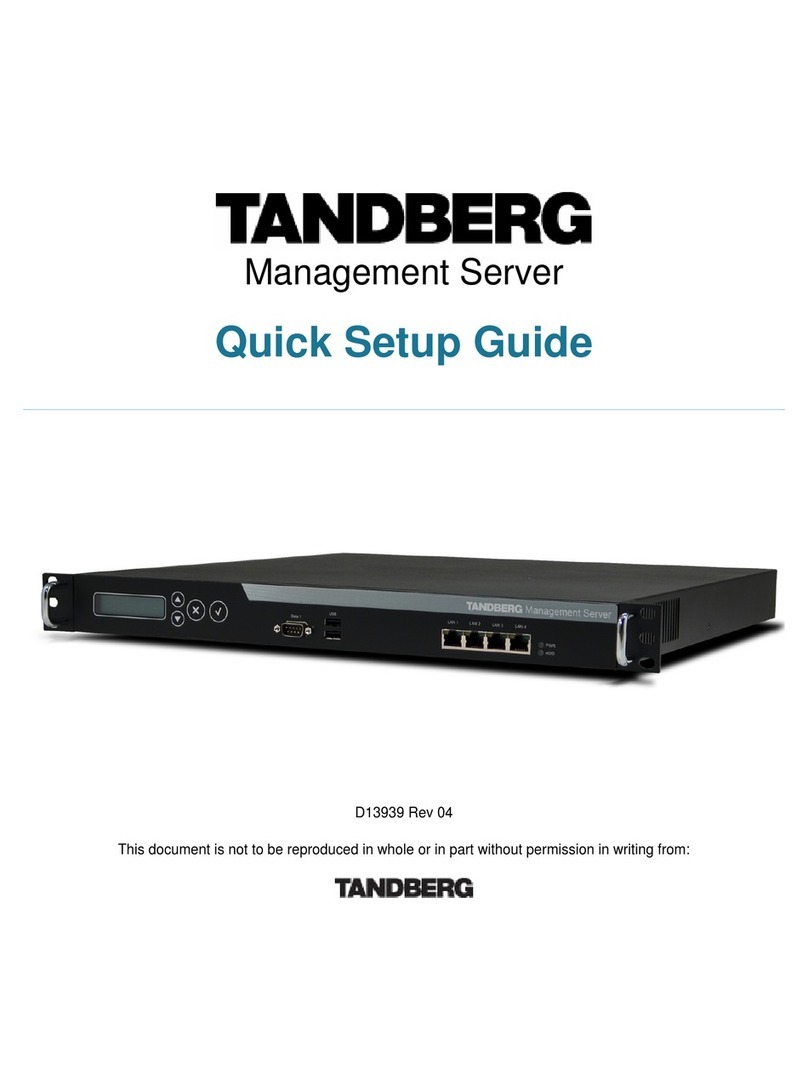
TANDBERG
TANDBERG Management Server D13939 User manual

TANDBERG
TANDBERG VCS Service manual

